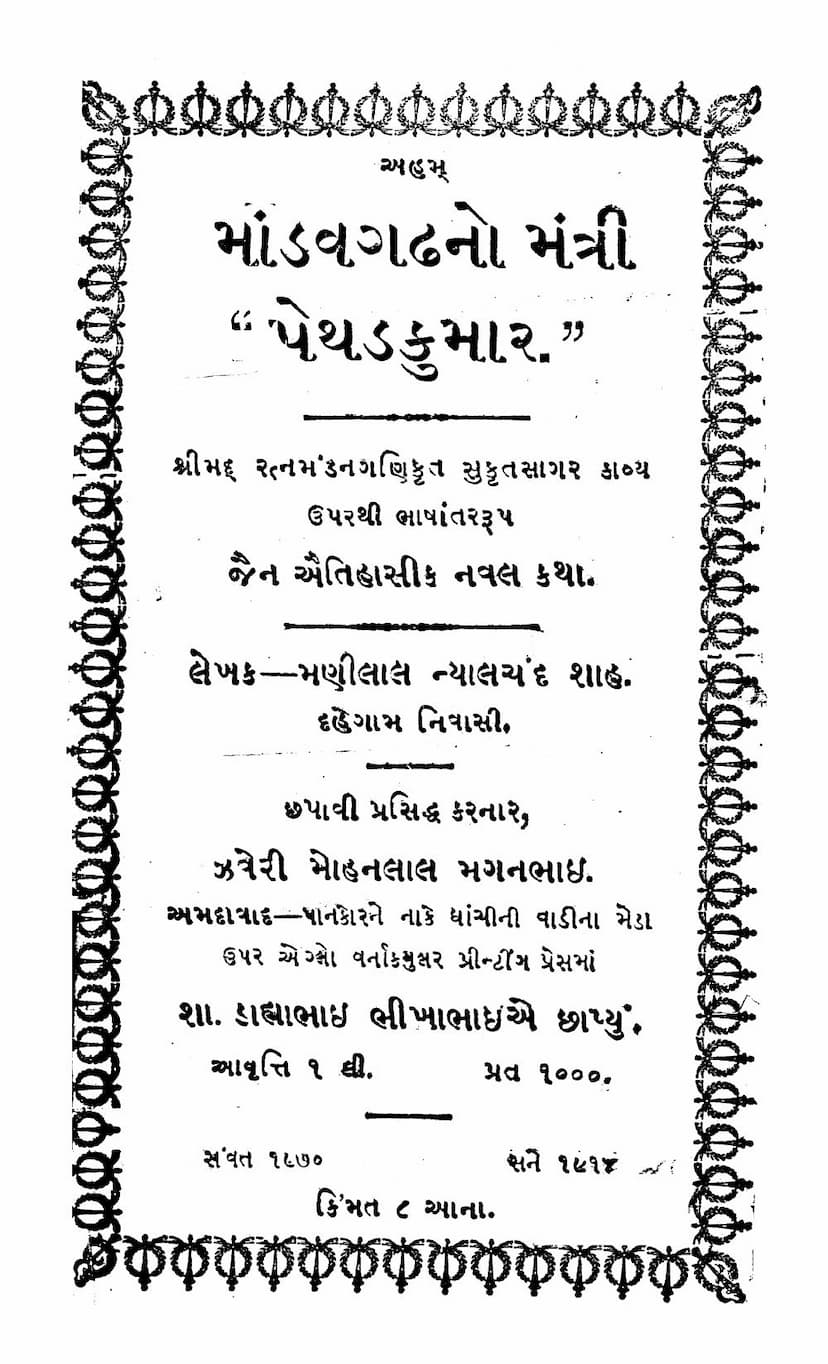Mandavgadhno Mantri Pethad Kumar
Added to library: September 2, 2025

Summary
This is a comprehensive summary of the Jain text "Mandavgadhno Mantri Pethad Kumar" by Manilal Nyalchand Shah, based on the provided pages.
Book Title: Mandavgadhno Mantri Pethad Kumar (The Minister of Mandavgadh, Pethad Kumar) Author: Manilal Nyalchand Shah (resident of Dahegam) Publisher: Mohanlal Maganbhai Zaveri (Ahmedabad) Context: This is presented as a historical novel translated from the poem "Sukrut Sagar Kavya" by Shrimad Ratnamandana Gani. It focuses on the life and deeds of Pethad Kumar, the minister of Mandavgadh, and his son Zazhanakumar.
Core Narrative and Themes:
The book aims to highlight the virtuous lives and significant contributions of Pethad Kumar and his son to Jainism and society. It emphasizes:
- Devotion and Generosity: Pethad Kumar and his son were renowned for their deep devotion to Jainism, their respect for gurus, and their immense generosity. They are compared to figures like Vastupal and Tejpal, who undertook significant temple construction and religious activities.
- Religious Contributions: The narrative stresses their role in building temples, spending vast sums of money in devotion, supporting spiritual leaders, and contributing to the welfare of the Jain community. They are also credited with protecting Jain pilgrimage sites.
- Moral and Spiritual Upliftment: The book intends to inspire readers by presenting the noble examples of Pethad Kumar and his son, encouraging them to use their wealth for good causes, foster religious devotion, and achieve spiritual progress.
- Historical Context: The story is set during the reign of Alauddin Khilji in Delhi, around the 12th and 13th centuries CE. It touches upon the political landscape of Gujarat, mentioning rulers like Karan Vaghela, Siddharaj, and Kumarpal, and the influence of figures like Prithviraj Chauhan. Mandavgadh itself is described as a once prosperous city, the capital of the Paramar dynasty, ruled by Rana Jaysinhdev during that era.
Key Characters and Events (as per the provided pages):
- Pethad Kumar: The central character, the minister of Mandavgadh. His life is depicted as one of hardship, debt, and despair initially, leading him to wander in a forest. He encounters a powerful yogi (likely Nagarjun) who reveals the secret of alchemy (Suvarna Siddhi). Pethad Kumar uses this knowledge to become wealthy and then generously spends his wealth on religious and charitable causes, including building temples and supporting the community. He is portrayed as a wise and virtuous individual who faces adversity with resilience and ultimately achieves both material success and spiritual merit. His story highlights themes of fate, perseverance, and the importance of good deeds. He faces political intrigue and false accusations but ultimately maintains his integrity.
- The Yogi/Nagarjun: A miraculous yogi who bestows the secret of alchemy upon Pethad Kumar.
- Deodashah: A wealthy merchant who, through the yogi's blessings, becomes prosperous. He is an example of someone who uses wealth for good.
- Vimalashri: Pethad Kumar's wife, who initially suffers from the lack of a child but later has a son, Pethad. She is depicted as a virtuous and devoted wife.
- Pethad: The son of Pethad Kumar and Vimalashri. He is born due to religious devotion and is a prodigy of intelligence. He grows up to be a learned and respected figure, marrying Padmini and later having a son, Zazhanakumar. He demonstrates great generosity and foresight, especially in managing his wealth and contributing to religious causes.
- Zazhanakumar: Pethad Kumar's son, who is also depicted as intelligent and learned.
- King Jaysinhdev: The ruler of Mandavgadh, who initially tests Pethad Kumar and later recognizes his worth. He also faces challenges, including a costly ritual involving ghee for his horses and later political machinations by his minister Gunga.
- Gunga: The envious minister who tries to undermine Pethad Kumar.
- Sripal: A gambler who faces severe consequences for his actions but is ultimately aided by the wisdom of his wife Lilavati and the compassion of Queen Leelavati, showcasing the power of repentance and divine intervention.
- Ramabai: A character mentioned in relation to a dream influencing Vimalashri.
- Mathur: A character whose story highlights the complexities of virtue and the consequences of actions.
- Lilavati: A virtuous queen who is falsely accused and then unjustly banished by the King but is later reinstated due to her unwavering righteousness and the intervention of others. Her story emphasizes the power of truth and virtue.
- Padmakar: A cunning gambler who deceives people and faces his downfall.
- Shri Dharmaghosha Suri: Pethad Kumar's spiritual guru, whose teachings and guidance are instrumental in Pethad Kumar's spiritual journey.
- Various Jain Monks and Scholars: Mentioned as recipients of respect and support, and integral to the religious activities described.
Themes of Jainism:
- Karma: The concept of karma is implicitly present, showing how past deeds influence present circumstances and how good deeds lead to positive outcomes.
- Ahimsa (Non-violence): While not explicitly detailed in the initial pages, the Jain context suggests an underlying principle of ahimsa, evident in the focus on righteous living and charitable acts.
- Renunciation and Detachment: The pursuit of spiritual liberation and detachment from worldly possessions is a recurring theme, especially as characters progress in their spiritual journey.
- Importance of Virtuous Conduct: The narrative consistently praises characters who demonstrate compassion, honesty, generosity, and devotion.
Structure and Style:
The text is written in Gujarati, employing a narrative style that blends historical accounts with moral and spiritual lessons. It uses poetic language and references to religious scriptures and philosophical concepts. The chapters are structured around specific events and character developments.
Overall Impression:
"Mandavgadhno Mantri Pethad Kumar" appears to be a devotional and educational work, designed to impart moral and religious values through an engaging narrative. It aims to provide readers with inspirational stories of faith, perseverance, and the positive impact of virtuous actions within the framework of Jain philosophy and history. The inclusion of historical details about Mandavgadh and the political climate adds a layer of authenticity and depth to the story.